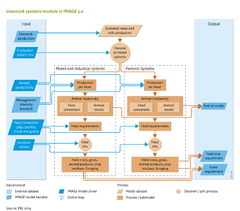Livestock systems/Policy issues: Difference between revisions
Jump to navigation
Jump to search
No edit summary |
No edit summary |
||
| Line 9: | Line 9: | ||
* the share of grass in the feed rations of cattle and sheep and goats, which will become smaller as some of the grass will be substituted by feed crops. | * the share of grass in the feed rations of cattle and sheep and goats, which will become smaller as some of the grass will be substituted by feed crops. | ||
* grazing, which will become more intensive. This would require better management of grasslands, including for example the use of grass-clover mixtures and fertilisers, bringing the length of the grazing season in tune with the period of grass production, and rotations. | * grazing, which will become more intensive. This would require better management of grasslands, including for example the use of grass-clover mixtures and fertilisers, bringing the length of the grazing season in tune with the period of grass production, and rotations. | ||
In the so-called Global Technology ( | In the so-called Global Technology (GT) scenario of the [[Roads from Rio+20 (2012) |Rio+20]] study, all such interventions have been combined, resulting in more production in mixed systems (+10%), larger carcass weights (+10%), higher off-take rates (+10%), more efficient feed conversion of sheep and goats (+10%), more feed crops (15%) and higher grazing intensities (15%). When included in the baseline scenario, this package leads to a considerable reduction in grassland area – by about 15% compared to the baseline scenario for 2050 (see the figure in the baseline scenario section). This then also leads to an increase in the area where biodiversity may develop. | ||
}} | }} | ||
Revision as of 16:13, 16 December 2013
Parts of Livestock systems/Policy issues
| Component is implemented in: |
| Components: |
| Related IMAGE components |
| Projects/Applications |
|
| Models/Databases |
| Key publications |
